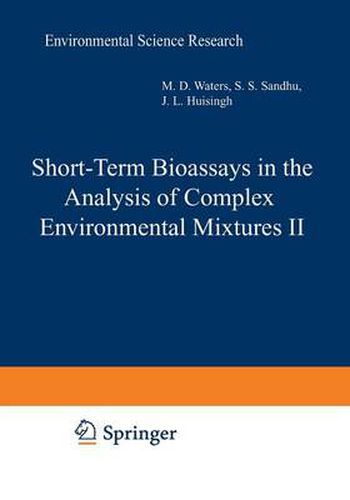Readings Newsletter
Become a Readings Member to make your shopping experience even easier.
Sign in or sign up for free!
You’re not far away from qualifying for FREE standard shipping within Australia
You’ve qualified for FREE standard shipping within Australia
The cart is loading…






This title is printed to order. This book may have been self-published. If so, we cannot guarantee the quality of the content. In the main most books will have gone through the editing process however some may not. We therefore suggest that you be aware of this before ordering this book. If in doubt check either the author or publisher’s details as we are unable to accept any returns unless they are faulty. Please contact us if you have any questions.
More than one hundred short-term bioassays are now available for detecting the toxicity, mutagenicity, and potential carcinogenicity of chemicals. These bioassays were developed and validated with individual compounds, and their principal application was perceived to be in evaluating the health hazard of such materials. However, man is rarely exposed to single chemicals; his exposure to hazardous chemicals is more commonly a multifactorial phenomenon. Although chemical analysis can be used to detect known hazardous compounds, it would be a staggering and expensive task to analyze large numbers of samples for all known or suspected hazardous constituents. Furthermore, the biological activity of a complex mixture cannot be reliably predicted from knowledge of its components. On the other hand, bioassays alone cannot tell us which components of complex mixtures are responsible for the biological activity detected. Thus, cost effectiveness and technical feasibility dictate stepwise and perhaps iterative application -of both chemical and biological methods in evaluating the health effects of complex environmental mixtures. Through the coupling of reliable biological detection systems with methods of chemical fractionation and analysis, it is frequently possible to isolate the individual chemical species that show biological activity. Initially, complex mixtures may be separated and bioassayed in carefully defined chemical fractions. The results of such short-term screening bioassays then may be used td guide the course of further fractionation and to determine the need for more stringent and comprehensive biological testing.
$9.00 standard shipping within Australia
FREE standard shipping within Australia for orders over $100.00
Express & International shipping calculated at checkout
This title is printed to order. This book may have been self-published. If so, we cannot guarantee the quality of the content. In the main most books will have gone through the editing process however some may not. We therefore suggest that you be aware of this before ordering this book. If in doubt check either the author or publisher’s details as we are unable to accept any returns unless they are faulty. Please contact us if you have any questions.
More than one hundred short-term bioassays are now available for detecting the toxicity, mutagenicity, and potential carcinogenicity of chemicals. These bioassays were developed and validated with individual compounds, and their principal application was perceived to be in evaluating the health hazard of such materials. However, man is rarely exposed to single chemicals; his exposure to hazardous chemicals is more commonly a multifactorial phenomenon. Although chemical analysis can be used to detect known hazardous compounds, it would be a staggering and expensive task to analyze large numbers of samples for all known or suspected hazardous constituents. Furthermore, the biological activity of a complex mixture cannot be reliably predicted from knowledge of its components. On the other hand, bioassays alone cannot tell us which components of complex mixtures are responsible for the biological activity detected. Thus, cost effectiveness and technical feasibility dictate stepwise and perhaps iterative application -of both chemical and biological methods in evaluating the health effects of complex environmental mixtures. Through the coupling of reliable biological detection systems with methods of chemical fractionation and analysis, it is frequently possible to isolate the individual chemical species that show biological activity. Initially, complex mixtures may be separated and bioassayed in carefully defined chemical fractions. The results of such short-term screening bioassays then may be used td guide the course of further fractionation and to determine the need for more stringent and comprehensive biological testing.